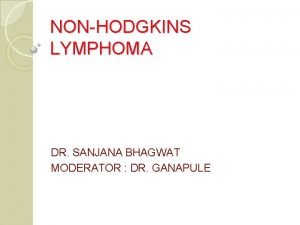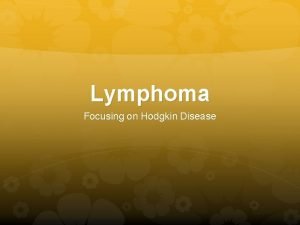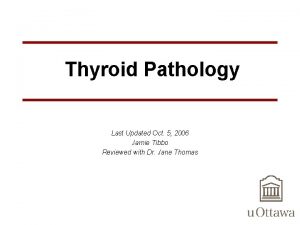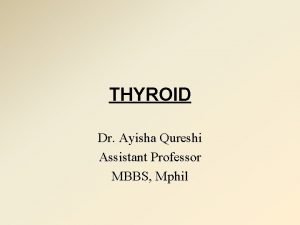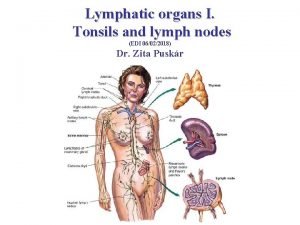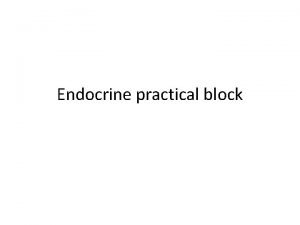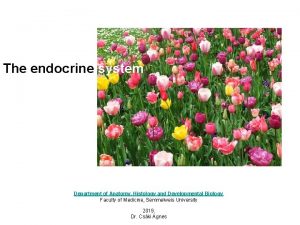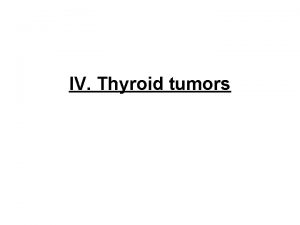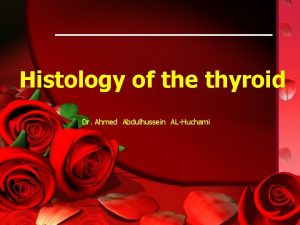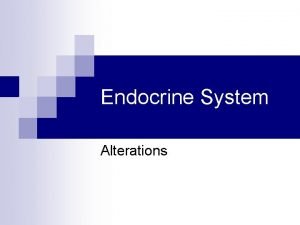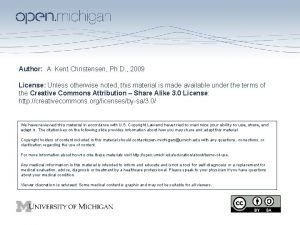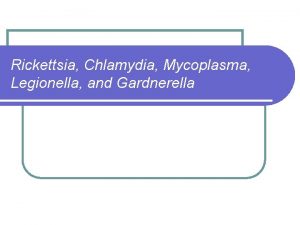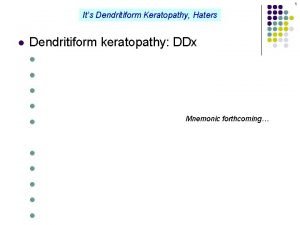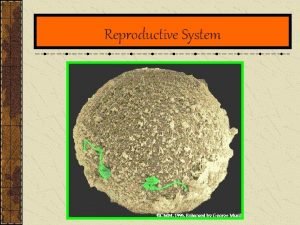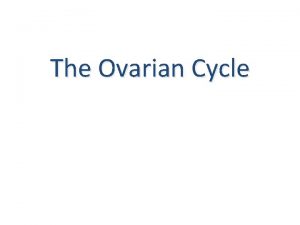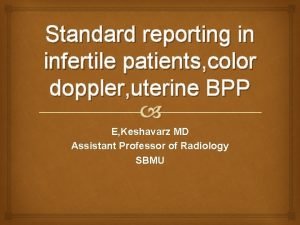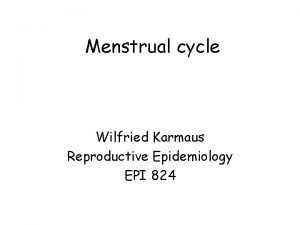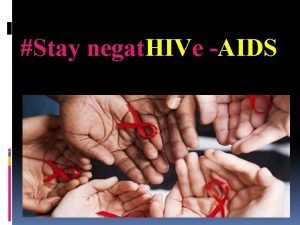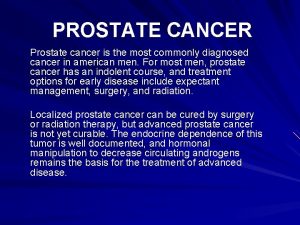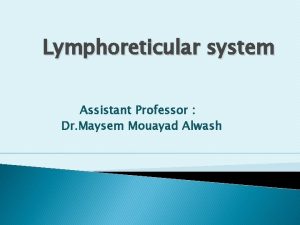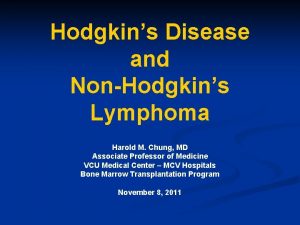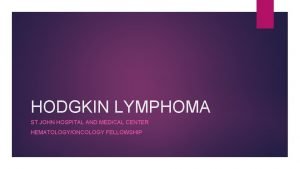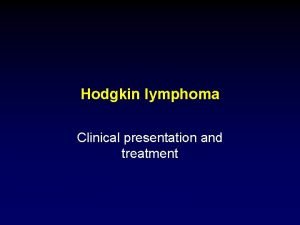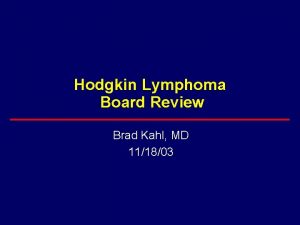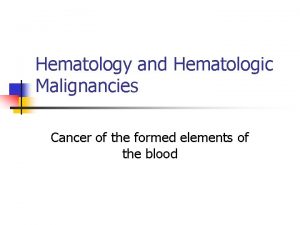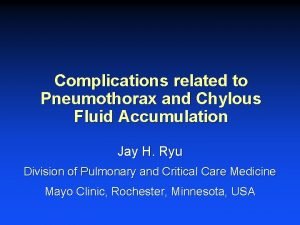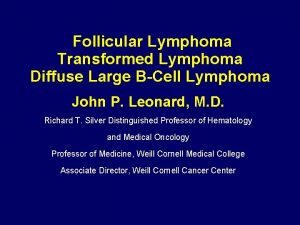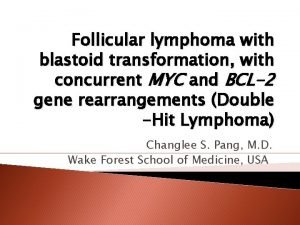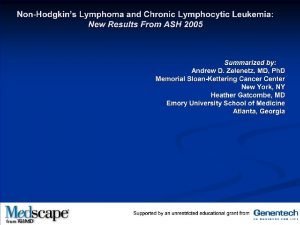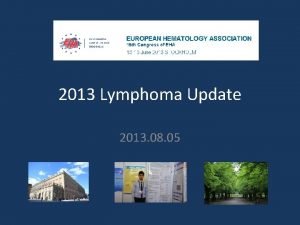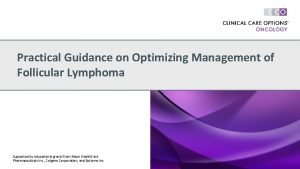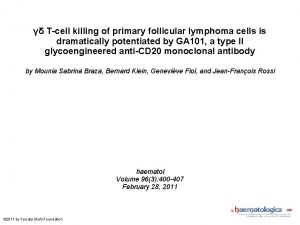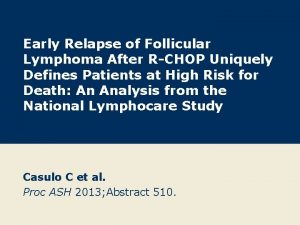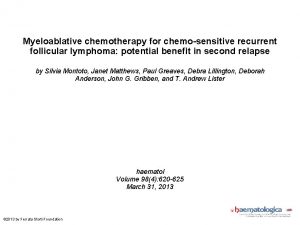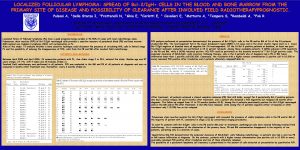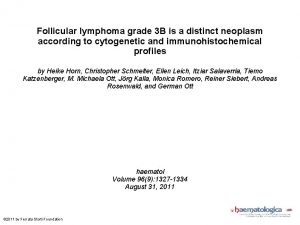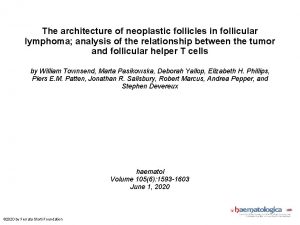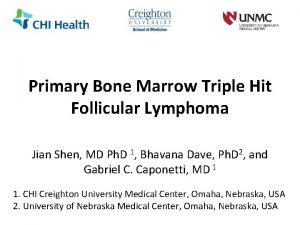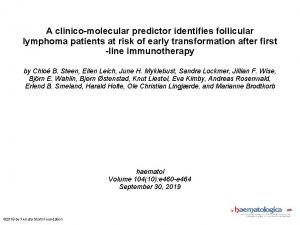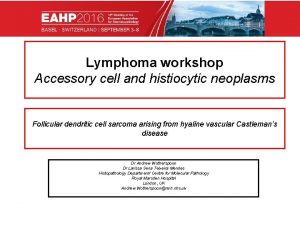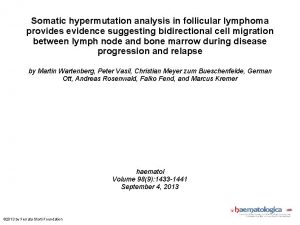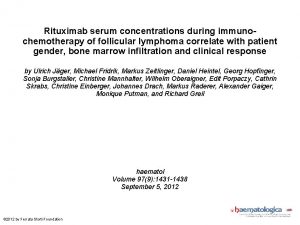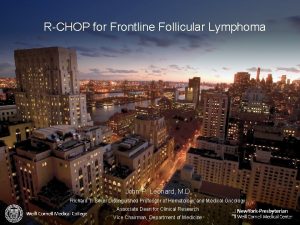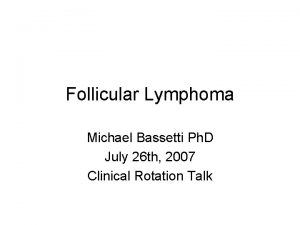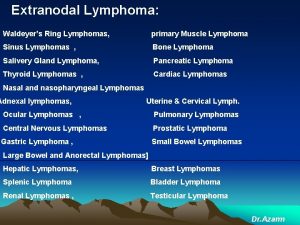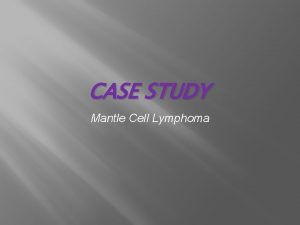Initial Therapy for Follicular Lymphoma Does it Matter
































- Slides: 32

Initial Therapy for Follicular Lymphoma – Does it Matter What Treatment We Use? Brad Kahl, M. D. Skoronski Chair of Lymphoma Research University of Wisconsin

FL Treatment • Disease generally “incurable” • Prognosis generally “good” • Lots of treatment options – Can make decision making difficult

My approach to a patient with newly diagnosed with FL Low Tumor Burden High Tumor Burden Symptoms absent Watch/Wait vs. single agent rituximab R-chemo +/- MR vs. Watch/Wait Symptoms present Single agent rituximab vs. R-chemo +/- MR

GELF Criteria – 3 nodes greater than 3 cm – Single node greater than 7 cm – Systemic symptoms or any symptoms – Compression or risk of compression of vital organ – Leukemic phase – Cytopenias due to marrow infiltration – Splenomegaly greater than 16 cm

Spanning the Continuum of Care: Optimizing Patient Outcomes in NHL clinicaloptions. com/oncology The Follicular Lymphoma International Prognostic Index (FLIPI) § FLIPI score used to predict outcomes of therapy based on adding number of risk factors (each factor = 1 point) – Older than 60 yrs of age – LDH > ULN – Ann Arbor stage III/IV disease – > 4 involved nodal sites – Hb < 12 g/L FLIPI Risk Group Low Intermediate High Risk Factors, n Patients, % 5 -Yr OS, % 10 -Yr OS, % Relative Risk 0 -1 36 90. 6 70. 7 1. 0 2 37 77. 6 50. 9 2. 3 ≥ 3 27 52. 5 35. 5 4. 3 Solal-Céligny P, et al. Blood. 2004; 104: 1258 -1265.

Symptomatic, High Tumor Burden FL Low Tumor Burden High Tumor Burden Symptoms absent Watch/Wait vs. single agent rituximab R-chemo +/- MR vs. Watch/Wait Symptoms present Single agent rituximab vs. R-chemo

Which chemo backbone? • R-CHOP vs. R-CVP vs. R-FM – No OS difference – R-CHOP and R-FM better PFS than R-CVP • 3 yr - 60% vs 47% – R-CHOP better safety profile than R-FM • Fewer infections • What about R-bendamustine? Federico et al, JCO April 2013.

Lancet, Feb 2013

PFS: follicular (n=279) 1. 0 Median (months) 0. 9 0. 8 B-R n. y. r. CHOP-R 40. 9 0. 7 0. 6 0. 5 0. 4 0. 3 0. 2 Hazard ratio, 0. 61 (95% CI 0. 42 - 0. 87) 0. 1 p = 0. 0072 0. 0 0 12 24 36 48 60 72 84 96 months MJR

Blood, May 2014

Primary Endpoint: Complete Response Rate Evaluable: IRC CR (95% CI) PR OR of CR + PR (95% CI) NI, noninferior; Sup, superior. BR (n = 213) R-CHOP/R-CVP P Value (n = 206) (NI) (Sup) CR Ratio 31 (25. 3 -38. 2) 25 (19. 5 -31. 7) 65 66 97 (93. 3 -98. 7) 91 (86. 0 -94. 4) 1. 26 (0. 93 -1. 73) 0. 0225 0. 1269

PFS: Investigator Assessment Randomized Patients (immature) 100 – Survival 80 – 60 – 40 – 20 – — BR — R-CHOP/R-CVP │ Censored 0– I I I I 0 4 8 12 16 20 24 I I 28 32 Months I I I I 36 40 44 48 52 56 60 64

Conclusions • R-bendamustine appears to be a reasonable alternative to R-CHOP • Stil Trial – More efficacious and less toxic • BRIGHT trial – Comparable efficacy – Toxicity tradeoff

What about maintenance rituximab (MR)? Lancet, Jan 1, 2011.


Maintenance Rituximab? • • Is PFS and time to next chemo benefit enough? Does QOL need to be improved by MR? Do infections cause concerns? Will patients respond less well to rituximab based regimens later? • What to tell patients? – I discuss “pros” and “cons”. – I find most (but not all) patients choose MR

RELEVANCE Study Design (Rituximab and LEnalidomide versus Any Ch. Emotherapy) 1 st line FL N=1000 R 2 Maintenance R + Chemo Rituximab Maint. R • R+Chemo: • Investigator’s choice of R-CHOP, R-CVP, BR • Lenalidomide 20 mg for 6 cycles, then 10 mg if CR • GELA + North American Cooperative Effort

Asymptomatic, High Tumor Burden FL Low Tumor Burden Symptoms absent Watch/Wait vs. single agent rituximab Symptoms present Single agent rituximab vs. R-chemo High Tumor Burden R-chemo +/- MR

Asymptomatic, High Tumor Burden • Generally recommend R-chemo followed by MR – Likely to recommend BR induction – MR optional as before • Some patients barely qualify as HTB – Reasonable to start on W&W but monitor closely for progression

Asymptomatic, Low Tumor Burden Symptoms absent Symptoms present High Tumor Burden R-chemo +/- MR vs. Watch/Wait Single agent rituximab vs. R-chemo +/- MR

Asymptomatic, Low Tumor Burden • Watch and wait remains a reasonable standard – 3 RCTs failed to demonstrate any overall survival advantage for immediate therapy • All in the pre-rituximab era – No trials of R-chemotherapy in this patient population – One trial of rituximab vs. watch and wait



How to interpret? • PFS benefit without an OS benefit – Does that warrant routine Rx with rituximab? – What endpoints do you and your patients value? • Is there a QOL benefit for associated with remission?

QOL Results • A minority of patients suffered from anxiety and depression (13% and 3%) • Patients assigned to rituximab had less anxiety than those on W&W • Most patients functioned quite well and adapted to their illness over time

My conclusions • Given lack of OS advantage, perfectly acceptable to W&W • Some benefits to rituximab – PFS and Time to Next Treatment – Discuss with patients • For a minority of patients with significant anxiety and coping issues, rituximab has benefit – Try and ascertain who these folks are • Some patients better served by rituximab

ECOG 4402 (RESORT) • Accruing 389 patients with low-tumor-burden stage III/IV FL Rituximab 375 mg/m 2 qw 4 CR or PR R A N D O M I Z E Rituximab maintenance 375 mg/m 2 q 12 w Rituximab re-treatment at progression 375 mg/m 2 qw 4 • Primary end point: time to rituximab failure • Secondary end point: time to first cytotoxic therapy http: //www. clinicaltrial. gov/ct/show/NCT 00075946? order=2. Accessed May, 2005.

E 4402 Results • No difference in time to treatment failure • Slight benefit in time to first chemo – 95% vs. 86% chemo free at 3 yrs • Came at a cost of 3. 5 x more rituximab • Both arms well tolerated – Slightly more toxicity on maintenance • Conclusion – Retreatment is our preferred strategy Kahl at el, JCO. In Press.

Symptomatic, Low Tumor Burden Symptoms absent Symptoms present Low Tumor Burden High Tumor Burden Watch/Wait vs. single agent rituximab R-chemo +/- MR vs. Watch/Wait R-chemo +/- MR

Symptomatic, Low Tumor Burden • CC is usually fatigue – Make sure not some other cause • Single agent rituximab seems reasonable – Low risk “experiment” • R-chemo – >95% response rate

Summary

Questions?
 Cerebriform nuclei
Cerebriform nuclei Lymphoma
Lymphoma Follicular adenoma
Follicular adenoma Parafollicular cells vs follicular cells
Parafollicular cells vs follicular cells Follicular cells
Follicular cells Stratified squamous non-keratinized epithelium
Stratified squamous non-keratinized epithelium Hashimoto thyroiditis
Hashimoto thyroiditis Thyroid follicle histology
Thyroid follicle histology Janos lobe
Janos lobe Follicular carcinoma of thyroid
Follicular carcinoma of thyroid Follicular epithelium
Follicular epithelium Follicular carcinoma of thyroid
Follicular carcinoma of thyroid Follicular cells of thyroid gland
Follicular cells of thyroid gland Dienes stain
Dienes stain Dendritiform
Dendritiform Oogenesis and follicular development
Oogenesis and follicular development Oogenesis
Oogenesis Ameloblastoma follicular
Ameloblastoma follicular Follicles in ovary
Follicles in ovary Follicular study
Follicular study Follicular phase
Follicular phase Psychoanalytic therapy is to as humanistic therapy is to
Psychoanalytic therapy is to as humanistic therapy is to Bioness integrated therapy system price
Bioness integrated therapy system price Humanistic therapies aim to boost
Humanistic therapies aim to boost Burkitt lymphoma
Burkitt lymphoma Indolent non-hodgkin lymphoma quizlet
Indolent non-hodgkin lymphoma quizlet Difference hodgkin and non hodgkin lymphoma
Difference hodgkin and non hodgkin lymphoma Nhl classification
Nhl classification Alcohol-induced pain in hodgkin lymphoma
Alcohol-induced pain in hodgkin lymphoma Mark juckett
Mark juckett Hodgkin's lymphoma classification
Hodgkin's lymphoma classification What is the difference between lymphoma and leukemia
What is the difference between lymphoma and leukemia Pleural space
Pleural space
